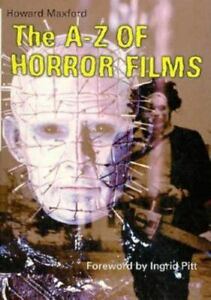|
The A-Z of Horror Films Book review by Thomas M. Sipos |
|
MENU Books Horror Film Festivals and Awards
Pursuits
Blogs Horror Film Festivals and Awards
Other
|
The A-Z of Horror Films (edited by
Howard Maxford,
Batsford LTD, 1996, 304 pp.)
But if the latest Creature Features requires 600 pages solely for films (albeit including science fiction and fantasy films), one suspects A-Z's 300 pages leave some letters missing. Maxford writes, "given the enormity of the task, there are bound to be some omissions." Yes indeed. Especially since Maxford's entries provide more than mere synopses and analyses. What is included is admirable, but uneven. Actor entries include filmographies, some extensive, some not. Actress Barbara Bach's brief entry itemizes her horror films, but none have their own film entries. Bela Lugosi's extensive entry did not prevent Maxford from including separate entries for Dracula and The Black Cat (but not for The Devil Bat). And why Bach but not Kay Lenz, whose work includes Initiation of Sarah, House, Headhunter? Why ŹSybil Danning but not Sandahl Bergman? Film entries offer production credits, some extensive, some not. New Year's Evil only credits its director, music, and cast. Scanners's entry lists its sequels, but none have their own entry. Only the first four Halloween films have entries, though Halloween's entry mentions V and VI. While Scanners and Halloween are seminal films, if New Year's Evil is included, why not dozens of other slasher fare? MIA are The Prey, Intruder, House of Death, the entire Silent Night, Deadly Night series (but curiously, not Silent Night, Bloody Night, nor Silent Night, Evil Night). It all feels very haphazard.Ź  Maxford says "the credit lists are perhaps the most comprehensive you'll find in any film guide." No. They're impressive, but the Overlook Encyclopedia contains entries A-Z lacks. Maxford earlier wrote the Overlook Press's Hammer, House of Horror: Behind the Screams. Unsurprisingly, A-Z's Hammer entry is extensive; for Monogram and PRC it's skimpy. Maxford specifies the color processing used in many films (Technicolor, Metrocolor, Eastmancolor, black & white, etc.), and less often their sound recording system.Ź Maxford admits "my views on certain films may be at variance with the reader's own personal taste and even received opinions. For this I make no apologies." Actually, his filmographies and production credits leave little room for plot synopses and analyses; Stanley's snippets are often more comprehensive. Instead, Maxford provides a four star rating system and "any name recorded within the body of the cast and credit lists in capitals denotes a stronger than usual contribution from the artist involved (e.g. Źd: TERENCE FISHER means that the film was particularly well directed)."Ź The A-Z of Horror Films is published by Indiana University Press. It's intelligent and accessible, but no more scholarly than many mainstream horror film books. Triple its content and it would become a formidable reference tool. The trade paperback is printed on heavy paper, three columns per page, nicely illustrated in black and white, and some gory color spreads. Also available clothbound. |
"Communist Vampires" and "CommunistVampires.com" trademarks are currently unregistered, but pending registration upon need for protection against improper use. The idea of marketing these terms as a commodity is a protected idea under the Lanham Act. 15 U.S.C. s 1114(1) (1994) (defining a trademark infringement claim when the plaintiff has a registered mark); 15 U.S.C. s 1125(a) (1994) (defining an action for unfair competition in the context of trademark infringement when the plaintiff holds an unregistered mark).font>


 This "A-Z" directory of horror films promises greater detail
than Stanley's
This "A-Z" directory of horror films promises greater detail
than Stanley's 